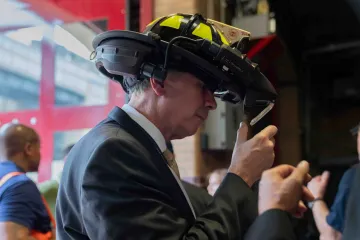
– Dimitri Kusnezov, Ph.D. Under Secretary for Science and Technology, DHS
May is a month to honor and celebrate our brave first responders, starting with the National Fallen Firefighters Memorial ceremony, National Police Week last week, and finally the 50th anniversary of National Emergency Medical Services (EMS) Week this week. S&T recognizes all emergency responders who provide lifesaving services to our nation’s communities, honors the sacrifices made by these highly skilled professionals, and continually works to develop technology solutions that improve their safety and effectiveness.
We recently had an opportunity to showcase some of our first responder technology at the inaugural World Fire Congress. Hosted in Washington, D.C., by the U.S. Fire Administration (USFA) and National Fallen Firefighter Association, the event welcomed delegates from 56 nations and two multilateral organizations to establish a global fire service leadership network.

As part of the event, I was touched to participate in a memorial service for our nation’s fallen firefighters alongside FEMA Administrator Deanne Criswell and U.S. Fire Administrator Dr. Lori Moore-Merrell. Later in the week, S&T team members facilitated discussions on emerging and evolving global fire challenges, including structure fire, climate change impacts, and firefighter health and safety. The insights shared during these discussions will guide multilateral collaboration over the next two years.

Additionally, S&T hosted an innovative World Fire Congress Technology Showcase at a nearby firehouse that highlighted the art of the possible, exploring how global fire services can apply new and developmental innovations to solve universal challenges. Moderated by the S&T team, this session included three mini panels focusing on increasing situational awareness during structure fires, building community resilience against climate change, and improving firefighter health and safety. These panels demonstrated fire service research and development for a standing-room-only audience, with presentations from S&T subject matter experts, performers, and partners. Attendees actively engaged with panelists as they showcased these S&T-funded innovations that have the power to make firefighters safer and more effective—let me tell you more about them:
- Navigating through dense smoke, flames, and debris while rescuing trapped or incapacitated civilians can disorient firefighters, which can have disastrous consequences if responders are unable to locate the exit route. The C-THRU Real-Time Indoor Visualization System is a helmet-mounted indoor visualization system that enables fire responders to detect exit routes quickly in smoke-filled environments.
- Today’s wildland firefighters are exposed to significant particulates while many wear only bandanas for protection. S&T’s wildland fire respirator is a huge improvement for wildland firefighter health and safety, as it is small, lightweight enough to carry comfortably, easy to put on and take off and has a replaceable filter and a rechargeable battery for continual field use.
- Early detection is critical to suppressing wildfires and saving lives. S&T’s beta wildfire detection sensor technology is designed to detect particulates and gases as close to ignition as possible, leveraging Artificial Intelligence to analyze sensor inputs, and provide advance warning and alerting capabilities to safeguard communities. We plan to deploy these sensors across the Hawaiian islands; the pilot will soon expand into Canada, California, Colorado, and Tennessee.
- Responders have consistently sought 3D in geolocation tracking solutions, and S&T’s partnership with NASA’s Jet Propulsion Laboratory resulted in POINTER, which allows responders to more precisely pinpoint locations, not only tracking teammates to the exact floor in a building, but also determining whether they are still or in motion.
- The H2Rescue truck is deployable disaster relief truck that runs on a hydrogen fuel cell/battery. The hybrid vehicle can be driven to disaster sites to provide power for up to 72-hours without refueling—a green way to support disaster response efforts.

